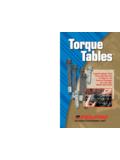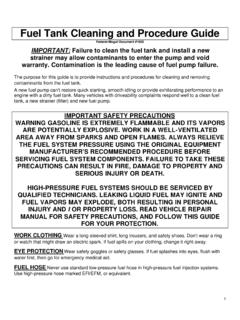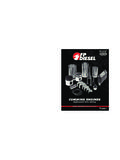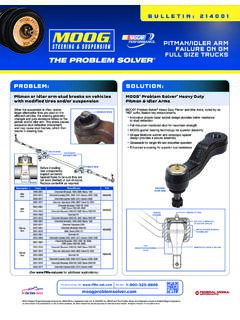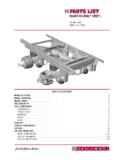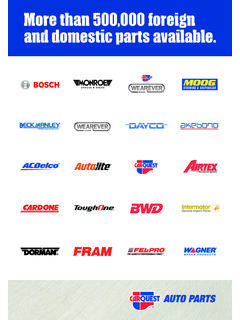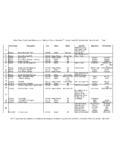Transcription of VALVE SELECTION GUIDELINES - Federal-Mogul
1 Comment: VALVE SELECTION GUIDELINES . Federal-Mogul Document #1108. MATERIAL SELECTION . When choosing valves for a performance engine, the most misunderstood subject is that of material SELECTION . Federal-Mogul offers valves in a variety of materials to meet the requirements of virtually any engine. Some of our competitors attempt to cover all applications with one or two VALVE materials - claiming that they can meet all the needs. An understanding of the environment in which the valves must function proves these claims to be false, as a single material cannot meet all operating requirements. The key difference between intake and exhaust valves is the temperature at which they operate. The exhaust VALVE is regularly subjected to highly corrosive exhaust gases at temperatures that may exceed 1400 degrees Fahrenheit.
2 In comparison, the intake valves are cooled by the incoming fuel/air mixture, and do not reach such high temperatures. The special intake VALVE alloys may actually be stronger than exhaust VALVE stainless when they are compared at the lower operating temperature of an intake VALVE . REPLACEMENT valves . Steel alloys such as Silchrome 1 (Sil 1) are used in many stock intake valves due to their strength at intake VALVE operating temperatures, relatively low cost, and the fact that they can be hardened at the VALVE tip for durability. Exhaust valves are made of 21-2N or 21-4N stainless steel, which offers greater high temperature strength and resistance to lead oxide corrosion. POWER FORGED STAINLESS STEEL valves . Power Forged high performance valves are manufactured in the USA from treated 21-2N stainless steel for great value and performance.
3 All Power Forged valves are of a one piece design, with the addition of a hardened tip. They feature a chrome plated stem, and a swirl polish finish. POWER FORGED COMPETITION SERIES valves . Our Super Duty Competition Series intake valves use heat treated 422 stainless, an alloy developed specifically for an intake VALVE 's unique operating conditions. This material easily outperforms many of the so called severe service valves on the market, with outstanding strength, and excellent resistance to fatigue and cracking. Like the standard Power Forged valves , the Competition Series exhaust valves are manufactured from premium 21-2N. stainless alloys, but they receive additional heat treatment and go through manufacturing processes which add substantially to the overall strength and durability of the VALVE .
4 With these features, Competition Series exhaust valves are able to operate at extreme temperatures and high RPM levels. You can spend more money - but you cannot buy a better VALVE ! Inconel is a nickel alloy rarely used in automotive engines. It may be required for extremely high temperatures such as those found in turbocharged vehicles. Titanium is a strong, lightweight, but expensive material used in maximum output racing engines. The main benefit of titanium is a reduction in VALVE weight, allowing higher engine speeds and increased power potential. VALVE HEAD DESIGN. VALVE head shape and size are critical to engine performance. Key areas are head diameter and seat angle. valves with a dished area on the combustion chamber side of the head are usually a little lighter, but sacrifice some compression ratio by increasing chamber volume.
5 VALVE head diameter has a direct impact on airflow and engine power. Ideally the VALVE should be large enough so that it is not a restriction to airflow through the cylinder head. Larger valves can be installed in many cylinder heads for improved power potential. Increasing the diameter does have a down side. As a significantly larger VALVE will lessen low end throttle response and torque. Proper size SELECTION is a compromise between low RPM performance and top end power, with the intended use of the engine being the determining factor. Intake valves are normally about 25% greater in diameter than are exhaust valves (in non supercharged engines). 1. VALVE SELECTION GUIDELINES - cont'd VALVE SEAT ANGLES. VALVE seat angles are usually determined by the engine manufacturer, although they are easily altered by the engine builder.
6 Unless you have access to a flow bench, t is best to follow the factory recommendations, as the seat angle can have a dramatic impact on performance. Focus your efforts on accuracy when machining the VALVE seat on the cylinder. Use multiple angles to locate the cylinder head seat contact area at the proper point on the VALVE face and maintain minimum seat widths of .045 on the intake, and .060 on the exhaust. A professional job will yield major performance improvement. UNDERHEAD FINISH - SWIRL POLISHING. The underhead shape and finish of the VALVE will also influence airflow. Our performance valves feature a machined underhead with a precisely formed radius to the VALVE stem and a finish designed to enhance both flow and VALVE strength. Swirl polishing provides two benefits - first is a possible airflow increase from removal of any forging irregularities from the underside of the VALVE 's head.
7 Second is a reduction of the potential for stress risers in the VALVE surface, the spiral pattern from this polishing process eliminates any surface scratches that might have extended to the edge of the VALVE . STEM DESIGN - DIAMETER AND UNDERCUT STEMS. The VALVE stem must serve as a bearing area for the VALVE guide, and it's tip must be durable enough to survive constant rocker arm contact. Stem diameter is determined by the desired strength and weight characteristics. Competition Series valves are available with an Undercut Stem. The reduced diameter in the region below the VALVE guide provides a measurable benefit in low lift airflow, along with a small reduction in VALVE weight. We also offer reduced stem diameter valves for additional weight reduction. VALVE PLATING AND CLEARANCE.
8 Chrome plating improves VALVE stem durability in situations where lubrication is marginal. This is particularly important on the exhaust side where high temperatures are present. To assist engine builders now using aggressive oil control techniques, we plate virtually all of our performance valves . Stem to guide clearances will differ depending on stem diameter, engine application, guide material, and on the type of stem seal selected. Stem that are too tight will cause more damage than those on the loose side of specifications. Clearances of .0015 - .0025 on the intakes, and .002 - .003 for exhausts are common. VALVE LOCK DESIGNS. The most common lock style is the single rectangular groove type, a design which has been proven in competition for decades. Parts for this design are available in a variety of materials and angles to meet any need.
9 Multi-groove type locks have been used in engines for several years. These allow the VALVE to rotate independent of the VALVE spring and retainer, keeping the seating surfaces clean of debris and promoting VALVE longevity. While street driven vehicles use multi-groove locks without problems, we recommend the single groove style for performance applications. Recently the single radius type groove has been introduced to the market. This is not a new design, as it has been used in Eu8rope for many years. While eliminating the corners of a rectangular groove, radius grooves are only needed for very small stem diameter valves that have marginal strength. It is rare for an automotive VALVE of any type to fail in the keeper groove area. VALVE TIP DESIGN. The tip of the VALVE stem must be quite hard to withstand constant moving contact with the rocker arm.
10 The stainless steel valves cannot be hardened enough to meet this demand, and thus must use either a welded on hard tip or a removable lash cap. The non-stainless alloys are much more hardenable and do not require tips or lash caps. valves using the multi-groove keeper design must be hardened through the entire keeper groove area, thus requiring welded stems when used with stainless head materials. 2. VALVE SELECTION GUIDELINES - cont'd VALVE WEIGHT. VALVE weight can be an RPM limiting factor in racing engines, and should be considered when building an engine for high speed use. The intake VALVE gets the most attention in this area due to its larger size and mass. Reducing the stem diameter by undercutting the area below the guide offers a small reduction. Greater gains are possible by reducing the entire stem diameter, and altering the valves guides in the head appropriately.
